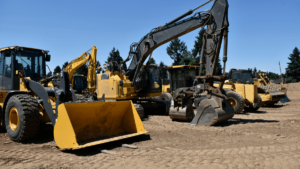Your fixed assets are your company’s operational foundation that you can’t do business without.
To make the most of your company’s assets and drive financial success, you have to be very deliberate when it comes to your fixed asset management processes—from purchasing, operating, and maintaining to depreciating, and disposing of.
This encompasses regular monitoring of your equipment, machinery, and vehicles, and ensuring they remain in optimal working order, thus enhancing their overall lifetime value.
To that point, effective fixed asset management enhances operational efficiency, improves project planning and asset allocation, and ensures regulatory compliance.
However, challenges like manual data entry errors, poor asset data management, and inadequate maintenance can impede the process.
In this article, we aim to explore the primary benefits of fixed asset management and delve into the key challenges that companies face in this journey, along with a few helpful strategies to help you streamline the process.
In this article...
The Benefits
Fixed asset management is the process of tracking and maintaining a company’s assets throughout their lifecycle in order to to optimize asset usage and ensure accurate financial accounting.
Efficiently managing your fixed assets can bring about numerous benefits.
Some of the most important ones are strengthened operational efficiency, accurate project planning, and compliance with rules and regulations.
Improved Operational Efficiency
By continuously monitoring the usage frequency and performance of fixed assets, companies can keep track of their condition and ensure they remain in good shape.
Therefore, a significant aspect of fixed asset management revolves around implementing regular preventive maintenance, enabling businesses to extend the operational lifespan of their assets.
This regular maintenance not only allows potential equipment issues to be detected and addressed early on, but prevents more serious problems from occurring down the line.

Taking good care of your equipment and machinery minimizes the chances of sudden breakdowns in the middle of a project, thereby reducing the number of incidents that could result in costly emergency repairs and project downtime.
In fact, research studies confirm that following a consistent preventive maintenance plan can reduce machinery repair costs by 25%.
In line with this, modern software solutions significantly ease the burden of some time-consuming tasks associated with the continuous management of your fixed assets.
For example, it often includes a feature for scheduling future maintenance tasks that will promptly notify your maintenance team when the next scheduled service is due.
Furthermore, asset management solutions keep all relevant asset information in one centralized database that enables mobile and remote access.
This allows your service technicians to review the equipment’s detailed maintenance records, swiftly grasp its current condition, and identify potential shortcomings.
Essentially, through establishing preventive maintenance schedules, fixed asset management helps minimize equipment failures, repair costs, and downtime.
This allows you to optimize your assets’ usage and improve the overall operational efficiency of your business.
Accurate Project Planning
If you’re in the construction business, you’re likely aware of the significant impact that project delays or downtime can have on your company’s efficiency and bottom line.
To prevent this and ensure the success of your projects, you need to carefully plan the allocation of your equipment and resources.
In that sense, tracking the whereabouts and performance of your equipment and tools is vital for accurate and effective project planning.
This is where a fixed asset management solution comes in to significantly streamline this process.
First of all, it allows instant access to updated information about the status and availability of your company’s fixed assets.
For instance, the GoCodes Asset Tracking asset management software enables workers to view and update asset information and quickly check equipment in and out whenever they need it, simply by using their phones or tablets.
The system promptly updates the central database, providing you with real-time information about the equipment’s current location, including who has it and when are they expected to return it.

In addition, fixed asset management software can help you ensure that essential pieces of machinery and equipment are well-maintained and deployed on time to their respective job sites.
In other words, knowing that an excavator you dispatched to a job site is in good working condition and has undergone maintenance will minimize the likelihood of unforeseen breakdowns in the middle of a project.
Furthermore, the software informs you about how many hours your assets have spent on different job sites, thereby helping you detect equipment that has been overused and might be at risk of malfunctions.
Likewise, you will have a clear picture of which equipment is underused or left idle, and decide whether a better option would be to sell it.
In essence, fixed asset management software will help you make sure no asset is lost, misplaced, or out of working order, thus enabling optimal asset allocation and accurate project planning.
Regulatory Compliance
One of the leading benefits of efficient fixed asset management rests on accurate financial reporting and compliance with accounting standards and regulatory requirements.
Properly managing your fixed assets will enable you to spot any financial irregularities early on and avoid the risk of legal issues, financial penalties, and damage to your company’s reputation.
In addition, staying compliant with regulations ensures that your financial records accurately reflect your company’s actual financial position, thus contributing to its stability and credibility.

To achieve this, it’s essential to track your fixed assets changing value throughout their lifecycle.
To that point, consistently tracking and calculating fixed asset depreciation is vital for managing tax liabilities effectively, considering that depreciation is a tax-deductible expense.
Hence, if you haven’t already done so, opt for an asset management software that runs automatic depreciation calculations using the appropriate depreciation method for each of your assets.
Commonly, this software feature generates detailed depreciation reports in line with the half-year (HY) convention required by the IRS, so they can be easily applied when filing financial statements or tax returns.
Asset management software solutions with built-in accuracy and compliance modules are designed to follow the latest tax code, accounting rules, and any tax updates, thus saving you valuable time and resources.
In essence, efficiently monitoring and managing your fixed assets will help you maintain organized financial records, and uphold compliant fixed asset accounting.
The Challenges
Fixed asset management comes with its own set of challenges, such as dealing with growing asset data, innate resistance to technological advancements, or frequent operational disruptions.
In the following sections, we explore the key challenges of fixed asset management, uncover their root causes, and discuss some effective strategies that can help you tackle them.
Accurate Data Maintenance
As your business expands, the quantity of your assets and the associated data increase in parallel.
Accurately handling the growing volume of asset-related data while managing assets across multiple locations and job sites can become a challenging task.
Moreover, the flow of information from various departments and disparate data systems, coupled with reliance on manual data-entry processes introduces an additional layer of complexity to data maintenance.
Namely, a lack of accurate and reliable data hampers your ability to gain total visibility into your fixed assets, including their performance, usage, and associated costs.
This can result in lost revenues and increased operating expenses, negatively impacting your company’s financial reporting and compliance, as well as your operational efficiency.

The most effective approach to address the challenge of data accuracy is to harness the power of technology.
A fixed asset management solution offers a centralized, cloud-based data system that allows you to integrate and standardize data from various sources and datasets throughout your company.
Moreover, the software enables automated real-time updates, thereby enhancing data accuracy and promoting seamless access to pertinent information across your departments.
Having remote access to comprehensive, accurate, and detailed records of all your assets will help you make better-informed decisions, optimize project planning and asset allocation, and drive your business forward.
Finally, when transitioning to a new asset management technology, choose software that is customizable, flexible, and scalable to adapt to your changing needs.
A software capable of seamlessly managing expanding fixed asset data and complexity will undoubtedly meet the growing needs of your evolving business.
Essentially, treating data as a valuable asset and implementing advanced fixed asset management processes will deliver substantial returns on investment sooner than expected.
Technology Adoption
There are lots of good technologies out there with the potential to streamline fixed asset management, offering companies substantial time and cost savings.
Early adopters of advanced tech solutions have capitalized on the numerous benefits these tools offer, elevating their operations to a whole new level of efficiency.
Yet, despite the proven advantages, some companies remain resistant to adopting and leveraging new technologies.
This is often stemming from a lack of vision or uncertainty that the investment would pay off.

Companies holding on to proven, but old-fashioned methods run the risk of dealing with scattered or incorrect asset data, resulting in inaccurate fixed asset accounting and compliance issues.
For example, managing a diverse range of fixed assets through standard spreadsheets is not only a time-consuming manual process but one that is often susceptible to inconsistencies and human errors.
In fact, studies have shown that on average, 88% of the Excel spreadsheets have errors.
Further on, the traditional usage of ERPs comes with its own shortcomings, such as the lack of adequate support for GAAP, depreciation, audits, and tax law updates, often requiring tedious data extraction and re-entry.
On the opposite side, automated fixed asset management solutions, such as GoCodes Asset Tracking, provide a single platform for managing all your asset data.
This central database, which can be accessed from any internet-connected device, offers complete visibility of your assets—including their location, utilization, and current condition—thus enabling you to coordinate projects and tasks with greater efficiency.
Additionally, GoCodes Asset Tracking software automatically integrates with other systems already in use, such as your enterprise tax and compliance systems or ERPs, without the need to manually reenter data.
However, its standout feature lies in its user-friendly interface—requiring nothing more than a smart device and the GoCodes Asset Tracking app.

The advantages provided by this solution have garnered recognition in Software Advice’s FrontRunners 2023 report, which identifies GoCodes Asset Tracking as the leading software product in terms of usability and customer satisfaction, as assessed through user reviews.
Embracing and integrating technological advancements into daily operations is a crucial step toward future growth and progress.
So, it’s worth giving it careful consideration.
Operational Disruptions
Poorly managed assets inevitably lead to unexpected downtime, disrupting business operations and causing project delays.
These issues might arise from equipment breakdowns caused by irregular maintenance, delayed replacements, or inadequate utilization of assets.
Despite your investments, if your assets and equipment fail, you will not see the projected return.
To put it differently—every time an operational disruption happens due to malfunctioning equipment, your company is losing money.
Construction project downtime means you’re throwing money in the air by covering expenses for:
- maintenance and repair technicians employed to fix the problem,
- expedited delivery of missing parts or materials,
- lost man-hours as they wait the issue to be resolved, and
- costly project delays and overtime shifts to make up for the lost progress.
In other words, frequent disruptions in your daily operations indicate that you might be doing something wrong when it comes to the way you manage your fixed assets.
To overcome this roadblock, you’ll have to turn things around and detect where and why your strategy is failing.
Considering all the aspects covered in this article, it’s clear that the solution to many fixed asset management challenges lies in adopting a robust digital solution.
Give it a try, and you’ll see—it’s the tool of the future.
Conclusion
Efficient fixed asset management is an essential business practice that can greatly improve your company’s operational efficiency, enabling timely and successful project planning and completion.
By adhering to sound management principles, you can mitigate risks associated with financial inaccuracies, regulatory non-compliance, inaccurate data, and operational disruptions.
The integration of modern tech solutions has proven instrumental in overcoming these challenges, thereby streamlining and enhancing your company’s fixed asset management.
So, if your goal is to sustain a healthy and profitable business and shape its strategic future, then it’s time to embrace technology.








